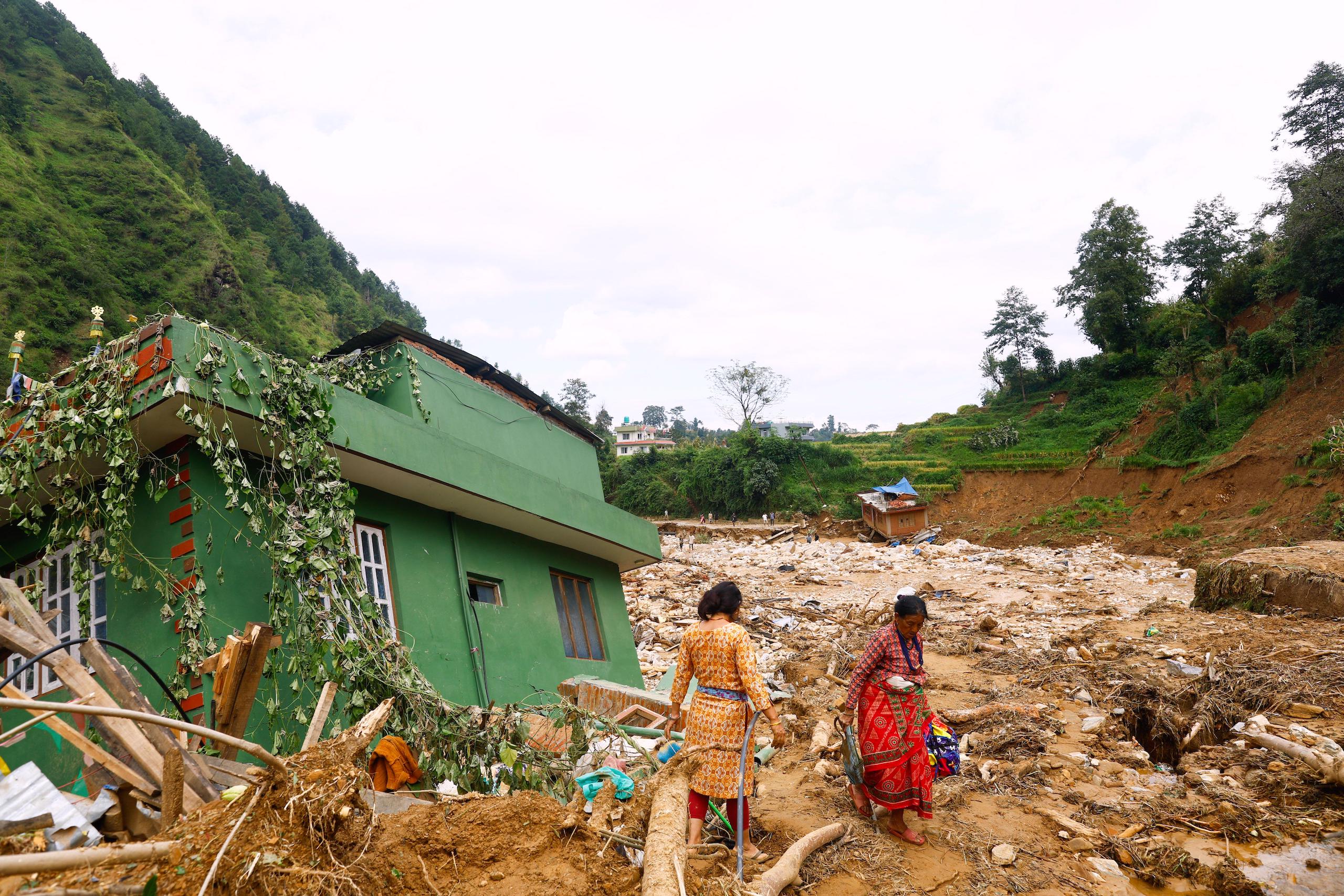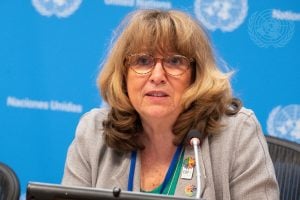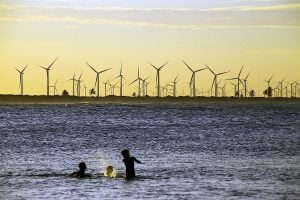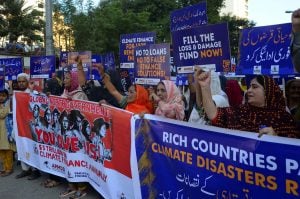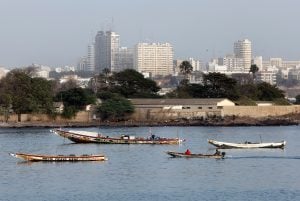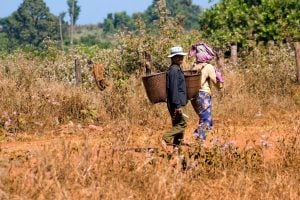When I landed in Kathmandu on 28 September, Nepal was experiencing its most intense rainfall in two decades. Landslides had severed roads from the city, bridges were overwhelmed and vehicles buried under the rubble. Over the next few days, news trickled in that over 200 hundred people had been killed.
In many ways, Nepal is on the frontlines of the climate crisis in the Himalayas. Its mountainous landscape magnifies the disproportionate impact of shifting weather patterns. There is growing fear over glacial lakes that threaten to burst their banks and concerns regarding what might happen as permafrost melts and destabilises mountainsides.
Nepal is informing itself about the climate crisis
It would be a mistake, though, to paint Nepali citizens as passive victims in the face of the climate crisis said Ramesh Bhushal. A longtime Nepal editor at The Third Pole project at Dialogue Earth, Bhushal has just published a Nepali language book, Chhalbato; Kailash Dekhi Ganga Samma. The book documents his 2019 journey along the Karnali River, from its source on the Tibetan plateau through Nepal and across India, where he travelled by road and raft. The book has resonated with readers, selling out its initial print-run of 3,000 copies in less than a month, which Bhushal said indicated that Nepali readers are keenly interested in environmental issues. Nonetheless, he added, this interest does not always translate into appropriate action.
“Take the current disaster,” Bhushal said. “We had the knowledge and the meteorological department had issued warnings, but both the public and policymakers just continued with things without doing anything. This disaster was as much a result of a lack of listening to expert warnings as it was to do with climate change.”
Indigenous knowledge is also expert knowledge
What qualified as “expert knowledge” is itself a topic of debate. At the second International Conference on Indigenous-led Research and Education, organised by the Centre for Indigenous Peoples’ Research and Development (CIPRED), Pasang Yangjee Sherpa from the University of British Columbia spoke about how adaptation experiences of Indigenous communities are often ignored in mainstream climate research. More critically, William Sunderlin, an adjunct professor with decades of experience in forestry programmes, highlighted how research often had perverse incentives. He cited deforestation in Nepal, which has historically been framed by organisations such as the World Bank as a problem caused by impoverished communities plundering forest resources. Yet, Sunderlin argued, this ignores the greater impact of mining and timber companies. A perspective grounded in the lived experience of local people is needed to counter these biases, he said.
Similarly, Linda Waimarie Nikora, a professor at Auckland University, and a Māori herself, emphasised the need to see “with both eyes,” meaning that scientific research should merge with traditional knowledge. She referenced the 2023 Cyclone Gabrielle, which devastated Māori settlements in New Zealand. Māori communities had not been part of the disaster preparedness response, and the state could not respond because Navy ships and helicopters were unable to reach affected areas. Māori communities were forced to rally together, reverting to traditional communal pooling of labour to rebuild homes. This approach was an excellent way of coming together to respond to climate-induced disasters when state mechanisms fell short.
Real-world examples against a backdrop of luxury
These deliberations, important as they were, were conducted at the sleek Hilton hotel, while much of the country struggled in the grip of disaster. Field trips were planned afterward for participants, but there were real-life examples of some of the issues discussed in Kathmandu itself. Former water resources minister Dipak Gyawali showed me some as we walked through Patan, an area devastated by the 2015 earthquake, that has been gradually rebuilt.
Gyawali maintains a sceptical attitude towards the term “Indigenous,” suggesting it makes more sense in states where colonisers from an industrialised culture displaced or conquered traditional communities, since there was a clear before and after. In countries like Nepal, however, where marginalised communities may have arrived only a few centuries ago, and dominant groups have a longer history, the term becomes more complex. Both dominant groups in urban settings as well as marginalised communities in rural or forested areas can claim indigeneity, and the difference has more to do with power dynamics and forms of development, including what Gyawali calls “mal-development” – or unsustainable development.
Traditional practices drawn from local cultures, like the pooling of labour for a community good, have value regardless of this debate, he said. A very clear example was the cleaning of Pimbahal Pokhari pond. “Local youngsters came together to clean this pond up in the core area of the city in the last few years,” he said, “and the area has [since] flourished. My mother still refers to it by the Nepali term which means ‘filthy pond’, though.” Next to it, a stupa complex – a traditional Buddhist monument often associated with sacred sites and meditation – has also seen renewed care. The stupa complex is said to have been built by a daughter of Emperor Ashoka’s daughters, two millennia ago, and is barely fifty feet from a temple complex linked to the Shankacharya tradition of southern India, which boasts a history of its own spanning over a millennium. Stupas often symbolise spiritual rebirth, a fitting metaphor for how community-driven efforts are breathing new life into this area. “As the pond was revived, the water table in the area improved, and dried-up old wells started functioning again,” Gyawali explained.
An electric future for Nepal?
The reconstruction of Patan, blending modernity and tradition, offers valuable lessons for sustainable urban development set within the backdrop of a growing climate crisis. On top of that, the city has seen a boom in the use of electric vehicles. Chinese electric cars, from the more affordable BYD options to the luxury Deepal brand, dominate the market, although the Indian EV option – the Tata Nexon – is also widely available. Kanak Mani Dixit, founding editor of Himal Southasian, a regional magazine, explained: “The expansion of electric vehicles in Nepal is a great departure, especially since here the electricity is based on renewable hydropower rather than coal-burning plants, but what we need is more electric-based public transport so that we have more clean air and import less petroleum.”
Given Nepal’s low per capita income of less than USD 1,500 per year, a relatively small proportion can afford personal cars, plus Kathmandu’s congestion means that private electric cars do not travel much on average daily. This is why he said that it makes much more sense for Nepal to encourage large electric buses for urban transport, even though these are expensive. For large-scale change, a wider adoption of electric-based transportation was needed, Dixit said, emphasising this key moment for South Asia’s transition. Despite the challenges the region faces, it is also an opportunity to innovate, he emphasised. “The old patterns of development have had their day. They won’t work for us anymore. Now is the time to create new one, and for Nepal for now our future is electric.”
